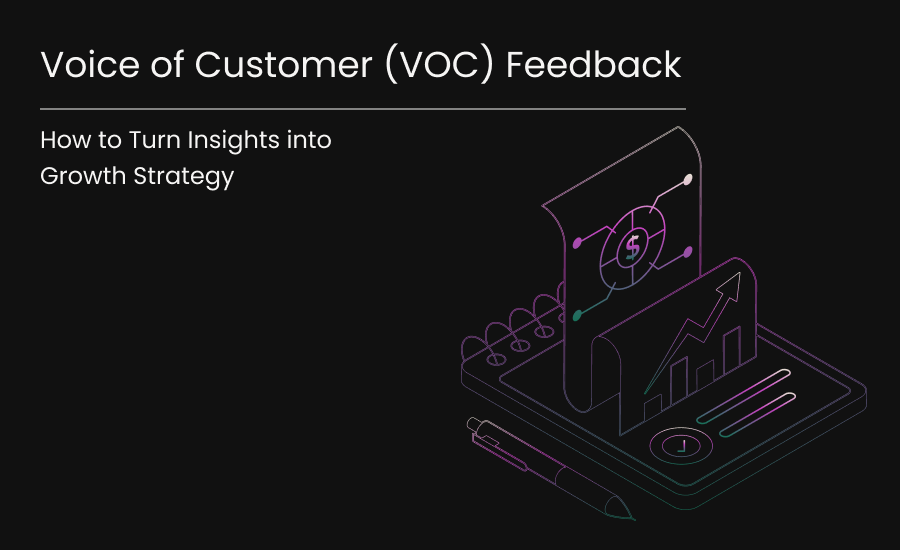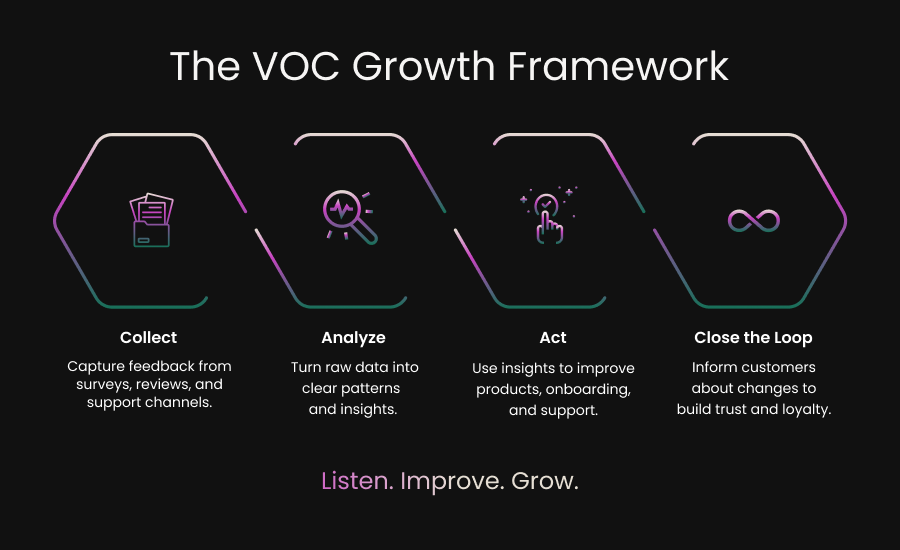RESOURCE ARTICLE
Voice of Customer (VOC) Feedback: How to Turn Insights into Growth Strategy

For SaaS businesses, this comes as no surprise. Products live or die by how closely they align with user expectations. When customer’s needs shape your product, adoption becomes smoother, retention improves, and loyalty grows naturally. Every new feature feels like it was designed with the customer in mind, and every interaction reinforces trust.
Voice of Customer (VOC) is more than just running surveys or tracking satisfaction scores. It is a structured way of listening to customers, identifying what truly matters to them, and making meaningful changes. It requires a mix of careful observation, pattern recognition, and decisive action. Companies that succeed with VOC do not just collect data; they close the loop by letting customers know their voices directly influence product and service decisions.
When executed well, VOC programs can reduce churn, strengthen customer relationships, and guide product roadmaps with confidence. They turn feedback into a source of competitive advantage, shaping decisions that improve onboarding, drive adoption, and lift Net Promoter Score (NPS) benchmarks in measurable ways. Over time, this creates a cycle of trust and growth: customers speak, companies listen, and loyalty deepens.
What Is the Voice of Customer (VOC)?
The Voice of Customer is a structured approach to capturing what customers are saying about your product and experience. It includes direct feedback through surveys, interviews, or support tickets, as well as indirect signals from reviews, community forums, or product usage analytics.
For SaaS companies, VOC holds a special weight. Every click, every support request, and every feature request is a clue about what users want. By paying attention to these signals, companies can avoid churn, invest in features that matter most, and deliver smoother onboarding journeys.
According to Forbes, Aberdeen Group research shows that companies using Voice of Customer (VOC) strategies achieve stronger revenue growth. That alone shows why VOC has moved from being a customer support initiative to becoming a growth driver.
What is the VOC Growth Framework?
The VOC Growth Framework is a practical approach to making customer feedback meaningful. Instead of treating surveys and comments as scattered data points, it organizes them into four clear steps that guide SaaS teams from collection to action. By following this framework, companies can uncover what customers truly need, act on those insights, and build lasting trust that strengthens retention and adoption.

1. Collect
Use structured surveys like NPS, CSAT, and CES alongside unstructured channels such as support tickets, social media mentions, and product reviews.
2. Analyze
Turn raw data into patterns. This includes sentiment analysis, feedback categorization, and identifying top recurring pain points or requests.
3. Act
Make changes where they matter most. This may involve refining onboarding steps, launching new features, or improving response times in customer support.
4. Close the Loop
Communicate back to customers. Share updates on what changed because of their feedback.
VOC Survey Types Compared
Different surveys capture different dimensions of customer feedback. For SaaS, knowing which one to use and when can make the difference between generic insights and actionable direction.
These survey types, when used in the right sequence, give SaaS teams a multi-dimensional view of their customers.
What Are the Key VOC Metrics and Formulas?
To measure the impact of Voice of Customer programs, SaaS companies rely on a few core metrics. These formulas turn customer feedback into numbers that can be tracked and improved over time.
- Net Promoter Score (NPS) = % Promoters – % Detractors
- Promoters score 9–10, Passives 7–8, Detractors 0–6.
- Example: 65% promoters – 20% detractors = NPS of 45.
- Customer Satisfaction (CSAT) = (# Positive Responses ÷ Total Responses) × 100
- Example: 160 positives out of 200 total = 80% CSAT.
- Customer Effort Score (CES) = Average score of responses on the effort scale
- Lower averages = easier customer experience.
What Are the SaaS Benchmarks for VOC Metrics?
Understanding where you stand compared to the industry helps set realistic and achievable goals. Benchmarks act as a guide to see if your VOC program is on track or falling behind.
- NPS: SaaS companies typically average between 30 and 40. Scores above 50 are considered world-class and usually reflect strong customer loyalty and advocacy programs.
- CSAT: The average across SaaS is about 78 percent. Companies that invest in smoother onboarding, faster support, and proactive customer success often see CSAT scores rise beyond 85 percent.
- CES: A score close to 1.7 on a 1–7 scale indicates customers find interactions easy and seamless. Anything above 3 suggests friction that could lead to frustration and eventual churn.
Consistently measuring these benchmarks allows SaaS businesses to replace guesswork with data. Instead of relying on anecdotal stories, leaders can see clear trends, identify strengths, and pinpoint weak spots that need attention. Over time, tracking these numbers provides proof that customer experience improvements are creating measurable business outcomes.
Case Studies: VOC in Action
Real SaaS companies have shown how VOC can directly influence retention, adoption, and product growth.
HubSpot: Shaping the Product Roadmap
HubSpot regularly runs feature validation surveys to understand what customers want next. When customers prioritized CRM integrations, HubSpot fast-tracked development and rolled them out in updates.
Zoom: Closing the Feedback Loop
Zoom treats customer feedback as a core part of its growth strategy. By listening closely to user input and acting quickly on requests, the company has been able to refine its platform, launch high-demand features, and build stronger relationships with its global customer base.
These examples show that VOC does not stay theoretical. It has a direct and measurable effect on customer retention, product stickiness, and overall brand loyalty.
What Are the Best Practices for SaaS VOC Programs?
Running a VOC program is not just about gathering feedback. To make it effective, SaaS companies need clear practices that turn insights into meaningful action and long-term growth. Best practices help ensure that feedback is captured at the right moments, analyzed with purpose, and tied directly to business outcomes.
When followed consistently, these practices improve customer retention, guide smarter product decisions, and create stronger trust with users.
- Embed feedback across the journey: Do not limit VOC to exit or renewal surveys. Capture insights at onboarding, mid-journey milestones, and post-support interactions.
- Use multiple listening channels: Combine structured surveys with reviews, community forums, support logs, and social media mentions to build a 360-degree view of the customer.
- Prioritize closing the loop: Customers want to know their feedback drives change. Sharing updates, even small ones, builds credibility and trust.
- Tie VOC to business outcomes: Link NPS or CSAT movements to churn reduction, ARR growth, or feature adoption rates. This keeps VOC from becoming a vanity exercise.
- Automate intelligently: Trigger micro-surveys when users complete key actions, like setting up an integration or resolving a support case. Automated timing ensures higher response rates and contextual feedback.
When combined, these practices help VOC move beyond being a reactive support tool and transform into a proactive driver of growth.
How Does VOC Connect to Growth Metrics?
Voice of Customer does not sit in isolation. It feeds directly into the metrics SaaS leaders already care about:
- Annual Recurring Revenue (ARR): A five percent reduction in churn through VOC-led initiatives can grow ARR by 25 to 95 percent over time.
- Product Adoption: Feedback-driven feature prioritization shortens time-to-value and increases stickiness.
- Net Promoter Score (NPS): A consistent seven-point rise in NPS often aligns with one percent revenue growth, especially when promoters become advocates.
VOC ties into broader frameworks such as customer adoption models and growth metrics dashboards. When customer voices flow into strategic planning, retention becomes measurable and growth more predictable.
Wrapping It Up!
Voice of Customer is not just about collecting feedback. It is a growth strategy that directly influences customer retention, product adoption, and overall satisfaction. By collecting insights, analyzing patterns, acting on them, and closing the loop, SaaS companies build trust and long-term loyalty.
The companies that listen and act on customer voices today are the ones that will grow faster tomorrow. By making feedback a core part of their strategy, they strengthen retention, accelerate adoption, and build loyalty that competitors struggle to match. Over time, this consistent focus on the customer turns into a growth advantage that is difficult to replicate.
Frequently Asked Questions
What is Voice of Customer (VOC)?
Voice of Customer is the structured process of collecting, analyzing, and acting on customer feedback to improve products, services, and customer retention.
How does VOC improve SaaS growth?
VOC reduces churn, accelerates product adoption, and informs the roadmap with real user insights.
What are the best VOC surveys for SaaS?
NPS, CSAT, CES, feature validation surveys, and in-app micro surveys are the most effective.
What’s the formula for NPS?
NPS = % of Promoters minus % of Detractors.
How do SaaS companies use VOC feedback?
VOC feedback refines onboarding, launches customer-requested features, and improves customer support experiences.
What is a VOC feedback loop?
VOC feedback loop is the process of informing customers about the changes you made based on their feedback, closing the loop to build trust.
How can SaaS businesses collect VOC feedback?
SaaS businesses collect VOC feedback through surveys, support tickets, interviews, community forums, and product usage analytics.







.svg)


.svg)

